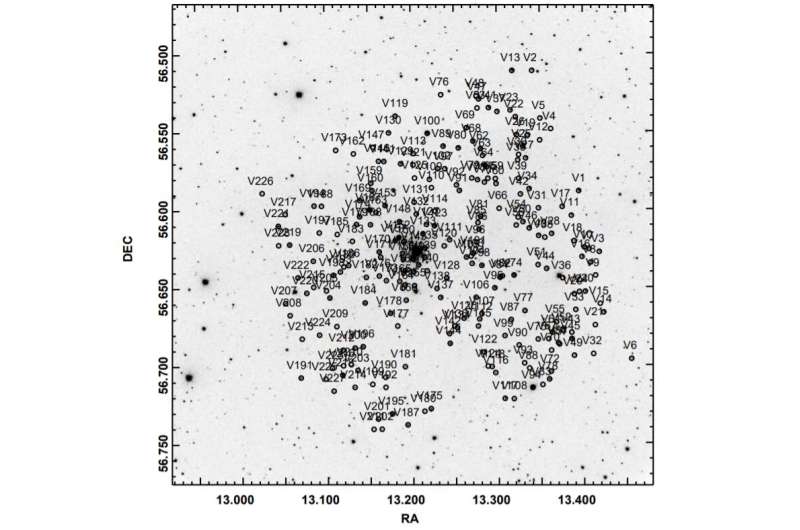April 13, 2021 report
Indian astronomers detect over 200 variable stars

Using the ARIES telescope, astronomers from India have inspected a young open cluster known as NGC 281, searching for new variable stars. As a result of this investigation, they detected 228 new variables. The finding is detailed in a paper published April 5 on the arXiv pre-print repository.
Variable stars could offer important hints into aspects of stellar structure and evolution. They could also be helpful for better understanding the distance scale of the universe. In particular, studies of variable stars in star clusters are of special interest for astronomers as they have the potential to help identify systematic errors that affect stellar distance indicators.
A team of astronomers led by Sneh Lata of the Aryabhatta Research Institute of Observational Sciences in India, has carried out a search for new variables as a part of the ongoing project called Search for Pre-Main-Sequence (PMS) Variability in Young Open Clusters (YOCs). Using the 1.30-m ARIES Devasthal optical telescope in Nainital, India, they have performed photometric observations of NGC 281 (dubbed the Pac-Man Nebula due to its morphology) an open cluster and a bright emission nebula some 9,300 light years away.
"We present time series data of stars in the region of the cluster NGC 281. The observations of the field containing NGC 281 were initiated in October 2010 and continued till November 2017," the researchers wrote in the paper.
The observations allowed the team to identify 228 variable stars in the field where NGC 281 is located; 81 of them turned out to be cluster members. The remaining 147 variables could belong to the field population. Fifty-one of the newly discovered members of NGC 281 are pre-main-sequence (PMS) stars, while the rest belong to the main sequence.
The majority of the newfound PMS variables are T Tauri stars, but Herbig Ae/Be stars are also present. When it comes to the 30 main sequence stars, they are Beta Cepheids, Delta Scuti, slowly pulsating B-type stars and new class variables. The remaining field stars could be RR Lyrae, Delta Scuti, or binary-type variables.
The study found that the amplitude and mass of the T Tauri variables of NGC 281 seem to be correlated as the relatively massive stars (with masses over 2.5 solar masses) have smaller amplitudes. The astronomers explained that this could be due to lack of disk or uniform distribution of spots on the photosphere of the stars.
The observations also found that in one subtype of the T Tauri stars in the cluster—weak-line T Tauri stars (WTTSs)—the amplitude of variability increases with age. This suggests that the distribution of spots on the surface of these variables changes with their age.
"It is interesting to note that the amplitude of variability of WTTSs show an increase for relatively older stars (...) It seems to suggest that configuration/distribution of spots on the photosphere of WTTSs changes as they become older," the astronomers concluded.
More information: Photometric observations of NGC 281: Detection of 228 variable stars, arXiv:2104.01859 [astro-ph.SR] arxiv.org/abs/2104.01859
© 2021 Science X Network





















